Comprehensive Financial Analysis: Daimler and Tesla Performance
VerifiedAdded on 2023/01/12
|17
|4610
|25
Report
AI Summary
This report presents a financial analysis of Daimler AG and Tesla, comparing their financial positions and performances over the last four years. The analysis includes a deep dive into liquidity, efficiency, profitability, and solvency ratios, such as current ratio, asset turnover, return on capital employed, and debt-equity ratio. The study reveals Daimler's established financial stability and profitability, despite fluctuating trends and declines in certain areas. Tesla, on the other hand, is shown to be struggling with continuous losses and negative returns, although it has demonstrated some improvements in reducing negative returns. The report examines the critical analysis of cash positions, highlighting the strengths and weaknesses of each company. It also uses horizontal and vertical analysis to assess revenue and expenditure trends. The findings provide insights into the financial health, market challenges, and strategic decisions of both companies, offering a comparative perspective on their performances within the automotive industry. This report is a valuable resource for understanding the financial dynamics of these two major players.
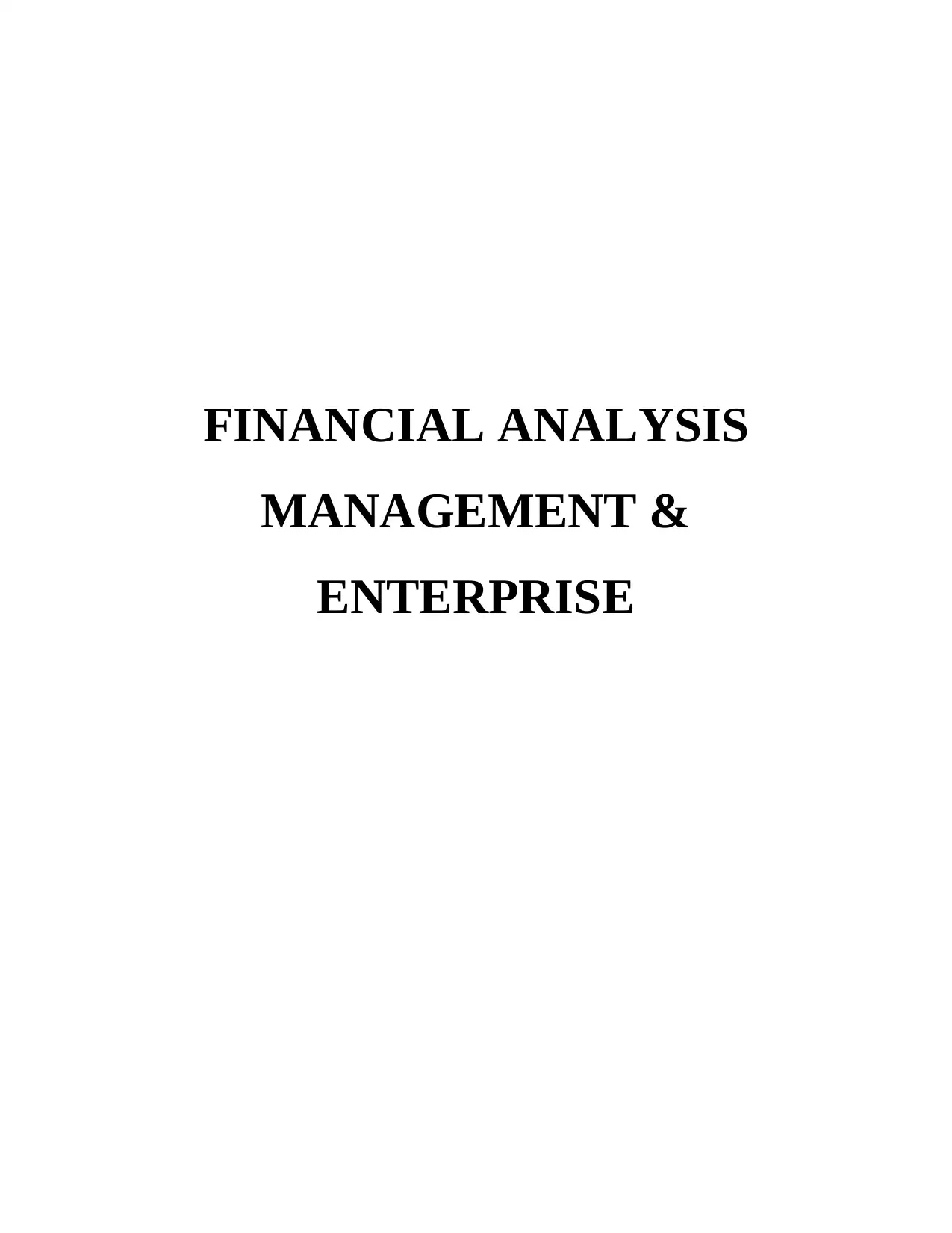
FINANCIAL ANALYSIS
MANAGEMENT &
ENTERPRISE
MANAGEMENT &
ENTERPRISE
Paraphrase This Document
Need a fresh take? Get an instant paraphrase of this document with our AI Paraphraser
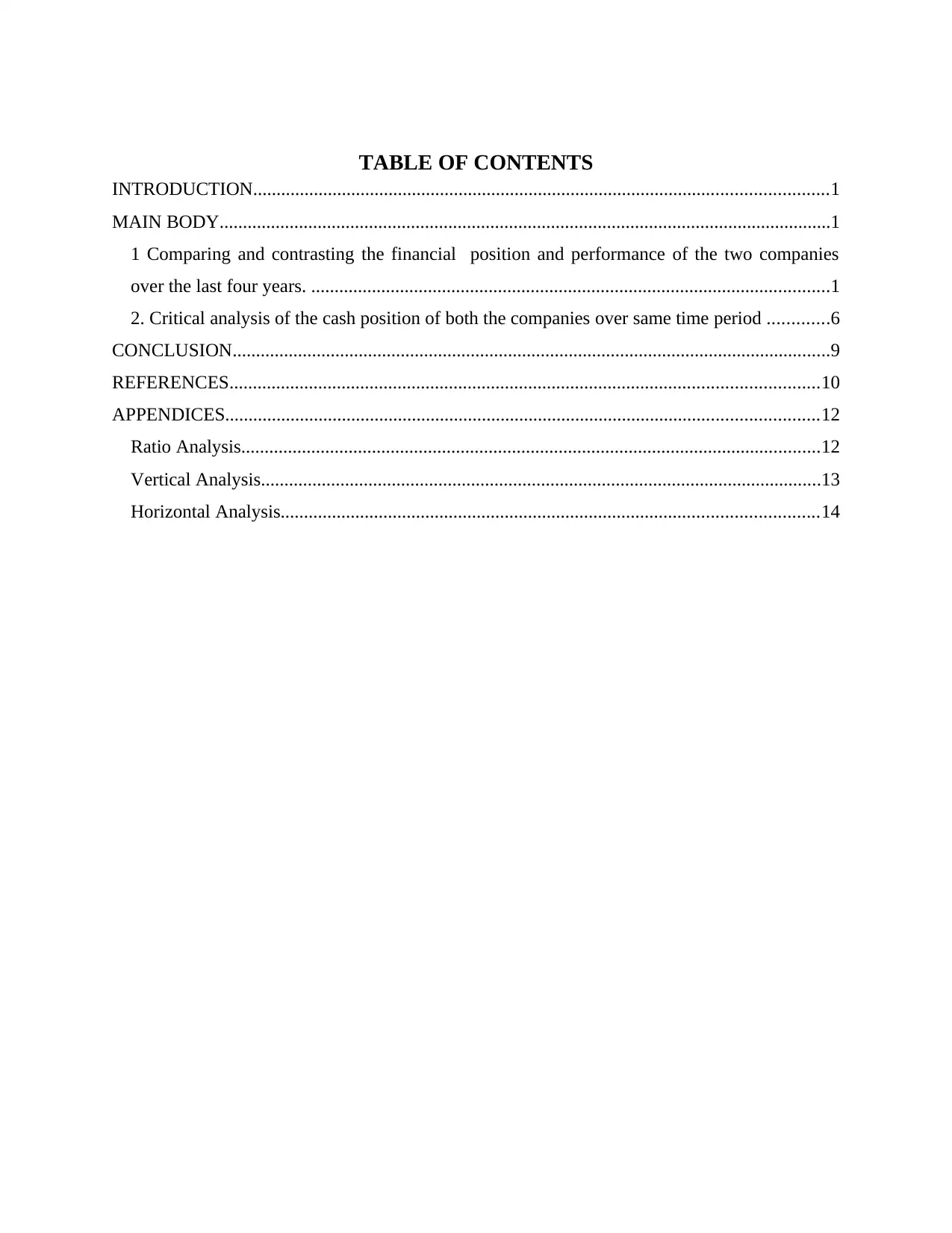
TABLE OF CONTENTS
INTRODUCTION...........................................................................................................................1
MAIN BODY...................................................................................................................................1
1 Comparing and contrasting the financial position and performance of the two companies
over the last four years. ...............................................................................................................1
2. Critical analysis of the cash position of both the companies over same time period .............6
CONCLUSION................................................................................................................................9
REFERENCES..............................................................................................................................10
APPENDICES...............................................................................................................................12
Ratio Analysis............................................................................................................................12
Vertical Analysis........................................................................................................................13
Horizontal Analysis...................................................................................................................14
INTRODUCTION...........................................................................................................................1
MAIN BODY...................................................................................................................................1
1 Comparing and contrasting the financial position and performance of the two companies
over the last four years. ...............................................................................................................1
2. Critical analysis of the cash position of both the companies over same time period .............6
CONCLUSION................................................................................................................................9
REFERENCES..............................................................................................................................10
APPENDICES...............................................................................................................................12
Ratio Analysis............................................................................................................................12
Vertical Analysis........................................................................................................................13
Horizontal Analysis...................................................................................................................14
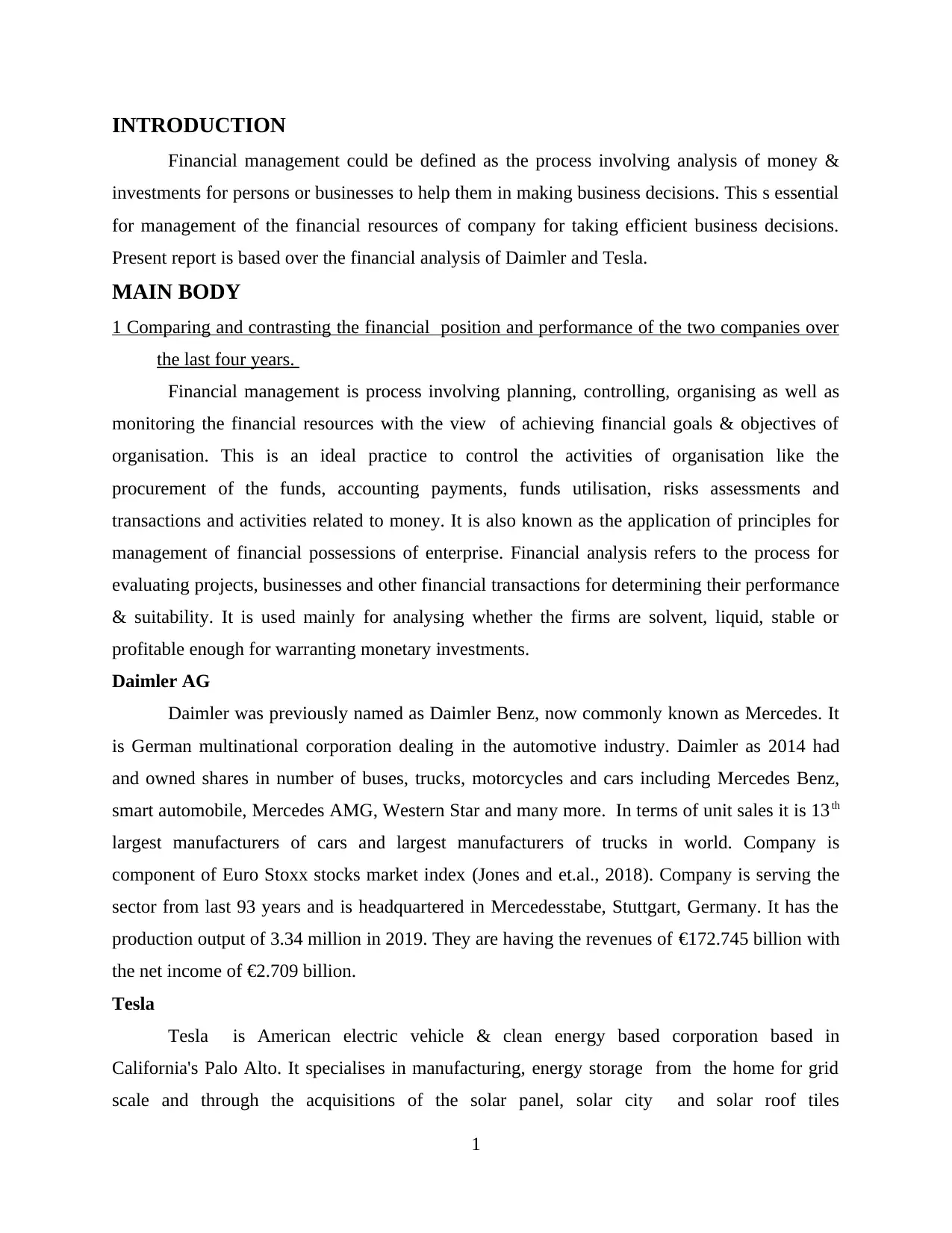
INTRODUCTION
Financial management could be defined as the process involving analysis of money &
investments for persons or businesses to help them in making business decisions. This s essential
for management of the financial resources of company for taking efficient business decisions.
Present report is based over the financial analysis of Daimler and Tesla.
MAIN BODY
1 Comparing and contrasting the financial position and performance of the two companies over
the last four years.
Financial management is process involving planning, controlling, organising as well as
monitoring the financial resources with the view of achieving financial goals & objectives of
organisation. This is an ideal practice to control the activities of organisation like the
procurement of the funds, accounting payments, funds utilisation, risks assessments and
transactions and activities related to money. It is also known as the application of principles for
management of financial possessions of enterprise. Financial analysis refers to the process for
evaluating projects, businesses and other financial transactions for determining their performance
& suitability. It is used mainly for analysing whether the firms are solvent, liquid, stable or
profitable enough for warranting monetary investments.
Daimler AG
Daimler was previously named as Daimler Benz, now commonly known as Mercedes. It
is German multinational corporation dealing in the automotive industry. Daimler as 2014 had
and owned shares in number of buses, trucks, motorcycles and cars including Mercedes Benz,
smart automobile, Mercedes AMG, Western Star and many more. In terms of unit sales it is 13th
largest manufacturers of cars and largest manufacturers of trucks in world. Company is
component of Euro Stoxx stocks market index (Jones and et.al., 2018). Company is serving the
sector from last 93 years and is headquartered in Mercedesstabe, Stuttgart, Germany. It has the
production output of 3.34 million in 2019. They are having the revenues of €172.745 billion with
the net income of €2.709 billion.
Tesla
Tesla is American electric vehicle & clean energy based corporation based in
California's Palo Alto. It specialises in manufacturing, energy storage from the home for grid
scale and through the acquisitions of the solar panel, solar city and solar roof tiles
1
Financial management could be defined as the process involving analysis of money &
investments for persons or businesses to help them in making business decisions. This s essential
for management of the financial resources of company for taking efficient business decisions.
Present report is based over the financial analysis of Daimler and Tesla.
MAIN BODY
1 Comparing and contrasting the financial position and performance of the two companies over
the last four years.
Financial management is process involving planning, controlling, organising as well as
monitoring the financial resources with the view of achieving financial goals & objectives of
organisation. This is an ideal practice to control the activities of organisation like the
procurement of the funds, accounting payments, funds utilisation, risks assessments and
transactions and activities related to money. It is also known as the application of principles for
management of financial possessions of enterprise. Financial analysis refers to the process for
evaluating projects, businesses and other financial transactions for determining their performance
& suitability. It is used mainly for analysing whether the firms are solvent, liquid, stable or
profitable enough for warranting monetary investments.
Daimler AG
Daimler was previously named as Daimler Benz, now commonly known as Mercedes. It
is German multinational corporation dealing in the automotive industry. Daimler as 2014 had
and owned shares in number of buses, trucks, motorcycles and cars including Mercedes Benz,
smart automobile, Mercedes AMG, Western Star and many more. In terms of unit sales it is 13th
largest manufacturers of cars and largest manufacturers of trucks in world. Company is
component of Euro Stoxx stocks market index (Jones and et.al., 2018). Company is serving the
sector from last 93 years and is headquartered in Mercedesstabe, Stuttgart, Germany. It has the
production output of 3.34 million in 2019. They are having the revenues of €172.745 billion with
the net income of €2.709 billion.
Tesla
Tesla is American electric vehicle & clean energy based corporation based in
California's Palo Alto. It specialises in manufacturing, energy storage from the home for grid
scale and through the acquisitions of the solar panel, solar city and solar roof tiles
1
⊘ This is a preview!⊘
Do you want full access?
Subscribe today to unlock all pages.

Trusted by 1+ million students worldwide
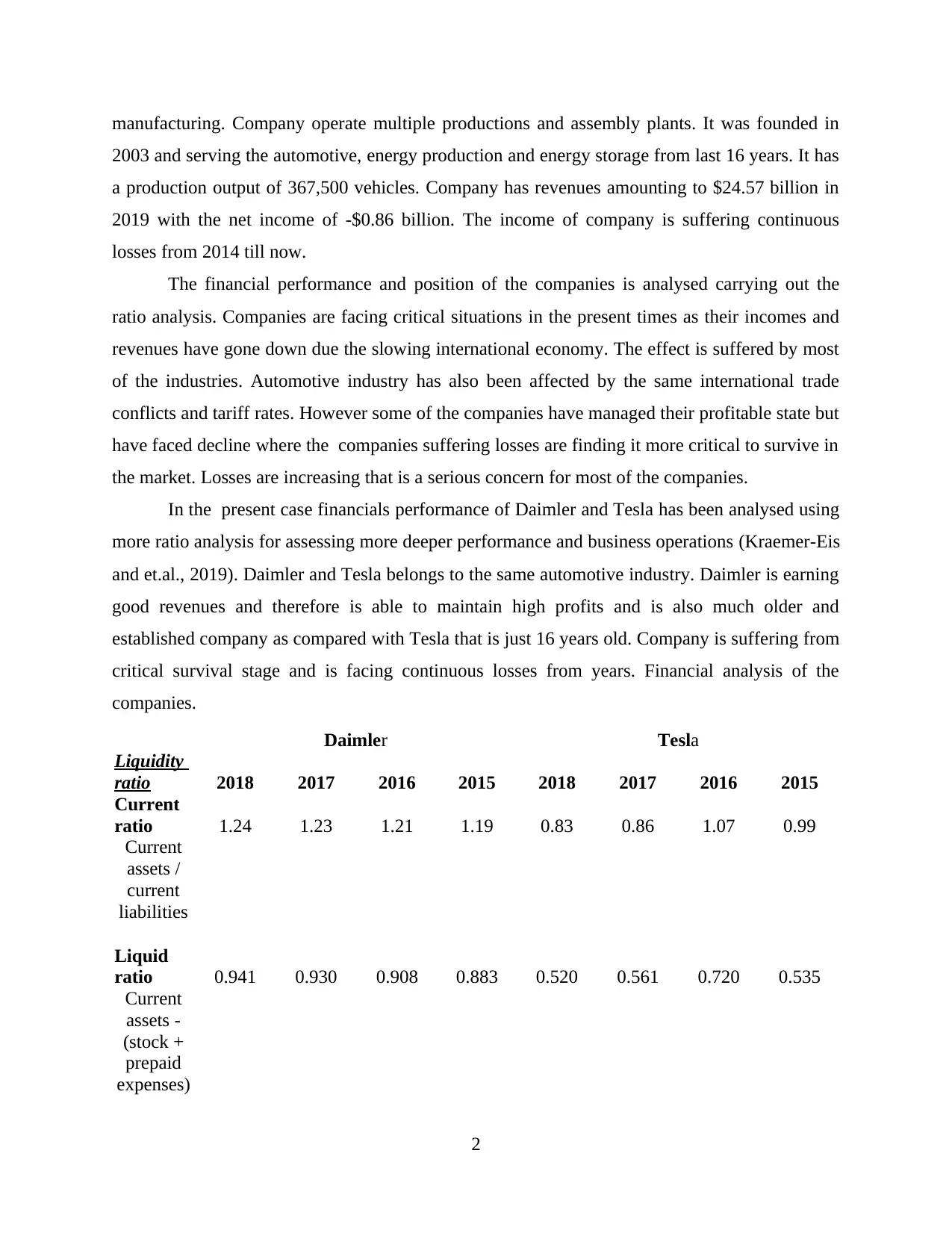
manufacturing. Company operate multiple productions and assembly plants. It was founded in
2003 and serving the automotive, energy production and energy storage from last 16 years. It has
a production output of 367,500 vehicles. Company has revenues amounting to $24.57 billion in
2019 with the net income of -$0.86 billion. The income of company is suffering continuous
losses from 2014 till now.
The financial performance and position of the companies is analysed carrying out the
ratio analysis. Companies are facing critical situations in the present times as their incomes and
revenues have gone down due the slowing international economy. The effect is suffered by most
of the industries. Automotive industry has also been affected by the same international trade
conflicts and tariff rates. However some of the companies have managed their profitable state but
have faced decline where the companies suffering losses are finding it more critical to survive in
the market. Losses are increasing that is a serious concern for most of the companies.
In the present case financials performance of Daimler and Tesla has been analysed using
more ratio analysis for assessing more deeper performance and business operations (Kraemer-Eis
and et.al., 2019). Daimler and Tesla belongs to the same automotive industry. Daimler is earning
good revenues and therefore is able to maintain high profits and is also much older and
established company as compared with Tesla that is just 16 years old. Company is suffering from
critical survival stage and is facing continuous losses from years. Financial analysis of the
companies.
Daimler Tesla
Liquidity
ratio 2018 2017 2016 2015 2018 2017 2016 2015
Current
ratio 1.24 1.23 1.21 1.19 0.83 0.86 1.07 0.99
Current
assets /
current
liabilities
Liquid
ratio 0.941 0.930 0.908 0.883 0.520 0.561 0.720 0.535
Current
assets -
(stock +
prepaid
expenses)
2
2003 and serving the automotive, energy production and energy storage from last 16 years. It has
a production output of 367,500 vehicles. Company has revenues amounting to $24.57 billion in
2019 with the net income of -$0.86 billion. The income of company is suffering continuous
losses from 2014 till now.
The financial performance and position of the companies is analysed carrying out the
ratio analysis. Companies are facing critical situations in the present times as their incomes and
revenues have gone down due the slowing international economy. The effect is suffered by most
of the industries. Automotive industry has also been affected by the same international trade
conflicts and tariff rates. However some of the companies have managed their profitable state but
have faced decline where the companies suffering losses are finding it more critical to survive in
the market. Losses are increasing that is a serious concern for most of the companies.
In the present case financials performance of Daimler and Tesla has been analysed using
more ratio analysis for assessing more deeper performance and business operations (Kraemer-Eis
and et.al., 2019). Daimler and Tesla belongs to the same automotive industry. Daimler is earning
good revenues and therefore is able to maintain high profits and is also much older and
established company as compared with Tesla that is just 16 years old. Company is suffering from
critical survival stage and is facing continuous losses from years. Financial analysis of the
companies.
Daimler Tesla
Liquidity
ratio 2018 2017 2016 2015 2018 2017 2016 2015
Current
ratio 1.24 1.23 1.21 1.19 0.83 0.86 1.07 0.99
Current
assets /
current
liabilities
Liquid
ratio 0.941 0.930 0.908 0.883 0.520 0.561 0.720 0.535
Current
assets -
(stock +
prepaid
expenses)
2
Paraphrase This Document
Need a fresh take? Get an instant paraphrase of this document with our AI Paraphraser
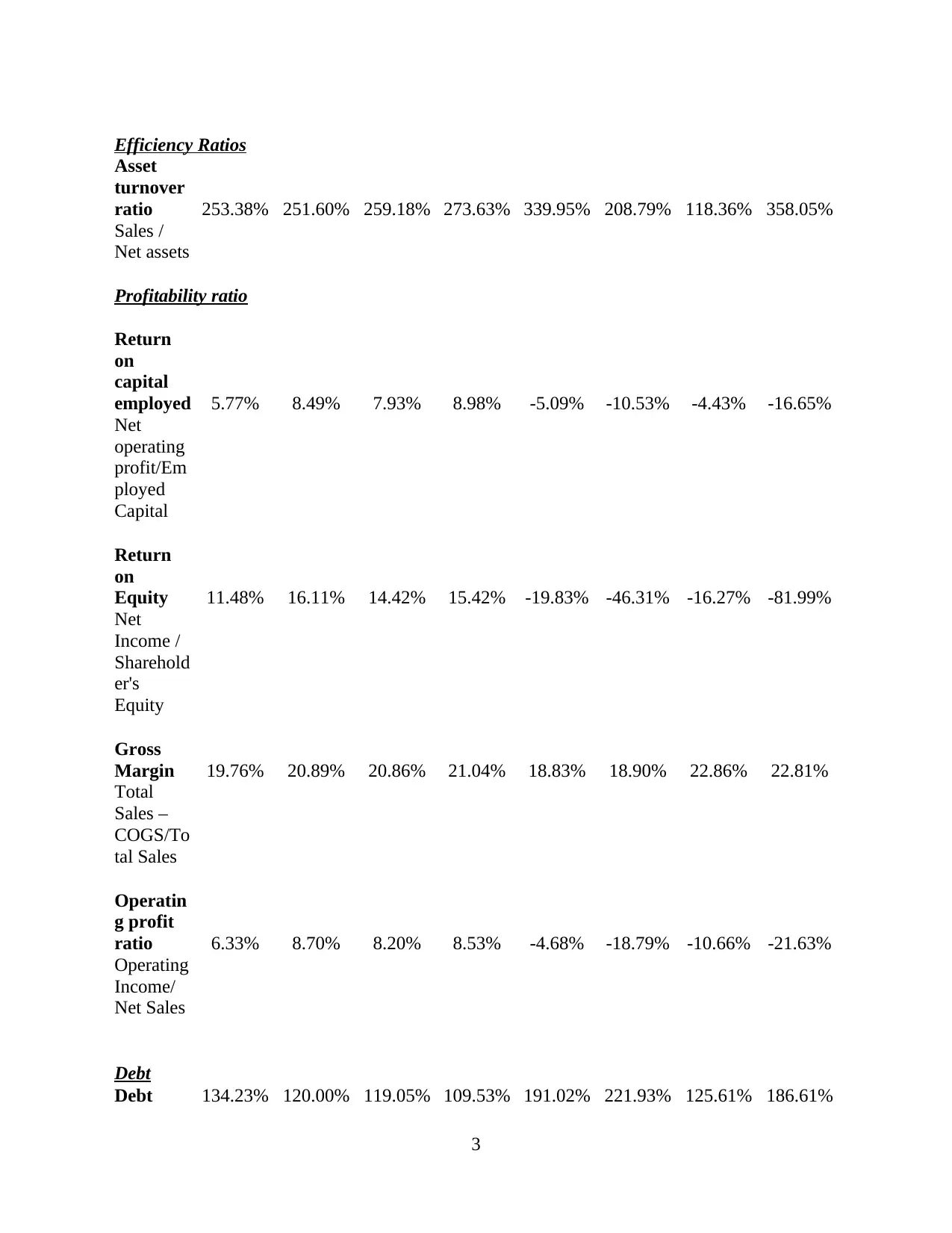
Efficiency Ratios
Asset
turnover
ratio 253.38% 251.60% 259.18% 273.63% 339.95% 208.79% 118.36% 358.05%
Sales /
Net assets
Profitability ratio
Return
on
capital
employed 5.77% 8.49% 7.93% 8.98% -5.09% -10.53% -4.43% -16.65%
Net
operating
profit/Em
ployed
Capital
Return
on
Equity 11.48% 16.11% 14.42% 15.42% -19.83% -46.31% -16.27% -81.99%
Net
Income /
Sharehold
er's
Equity
Gross
Margin 19.76% 20.89% 20.86% 21.04% 18.83% 18.90% 22.86% 22.81%
Total
Sales –
COGS/To
tal Sales
Operatin
g profit
ratio 6.33% 8.70% 8.20% 8.53% -4.68% -18.79% -10.66% -21.63%
Operating
Income/
Net Sales
Debt
Debt 134.23% 120.00% 119.05% 109.53% 191.02% 221.93% 125.61% 186.61%
3
Asset
turnover
ratio 253.38% 251.60% 259.18% 273.63% 339.95% 208.79% 118.36% 358.05%
Sales /
Net assets
Profitability ratio
Return
on
capital
employed 5.77% 8.49% 7.93% 8.98% -5.09% -10.53% -4.43% -16.65%
Net
operating
profit/Em
ployed
Capital
Return
on
Equity 11.48% 16.11% 14.42% 15.42% -19.83% -46.31% -16.27% -81.99%
Net
Income /
Sharehold
er's
Equity
Gross
Margin 19.76% 20.89% 20.86% 21.04% 18.83% 18.90% 22.86% 22.81%
Total
Sales –
COGS/To
tal Sales
Operatin
g profit
ratio 6.33% 8.70% 8.20% 8.53% -4.68% -18.79% -10.66% -21.63%
Operating
Income/
Net Sales
Debt
Debt 134.23% 120.00% 119.05% 109.53% 191.02% 221.93% 125.61% 186.61%
3
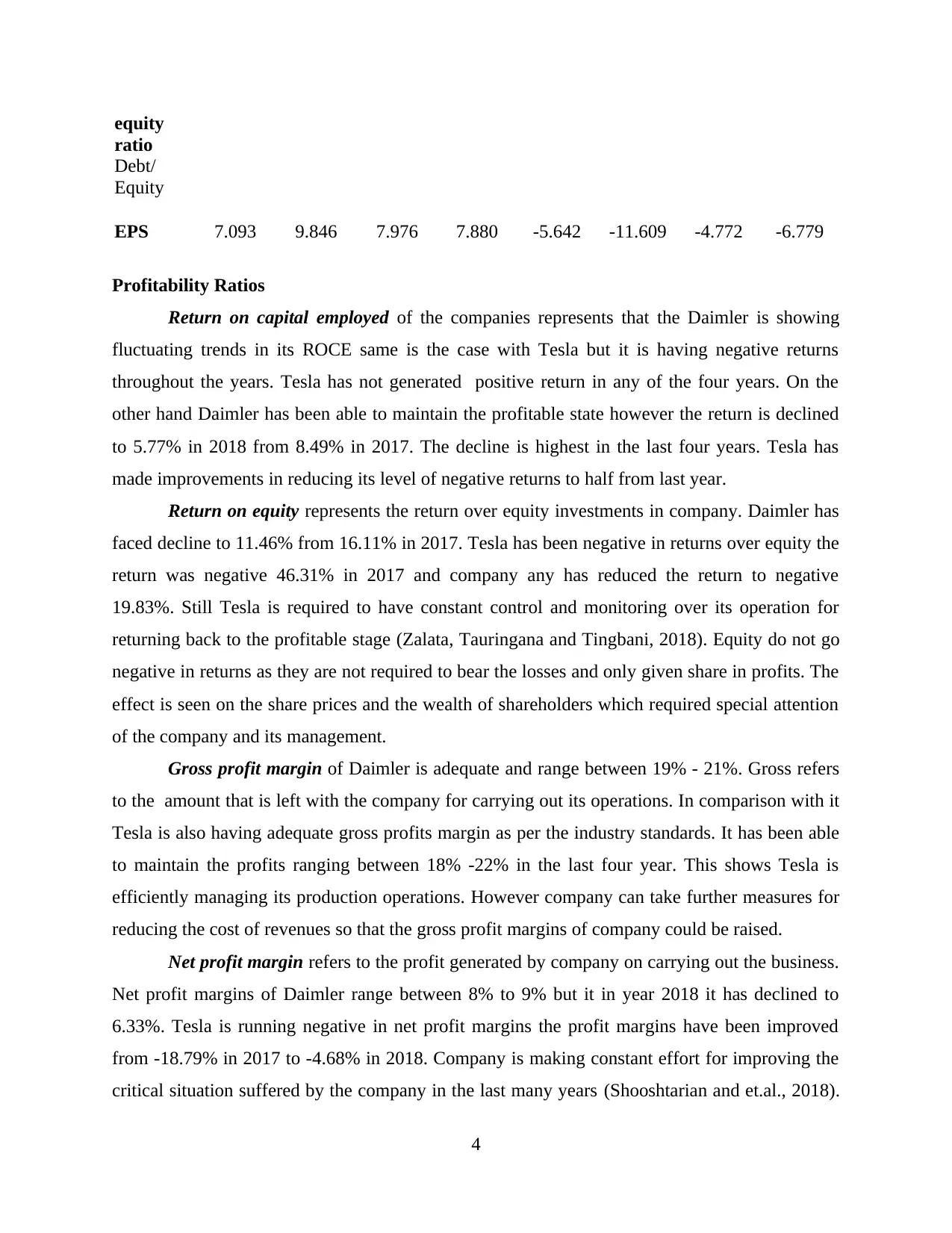
equity
ratio
Debt/
Equity
EPS 7.093 9.846 7.976 7.880 -5.642 -11.609 -4.772 -6.779
Profitability Ratios
Return on capital employed of the companies represents that the Daimler is showing
fluctuating trends in its ROCE same is the case with Tesla but it is having negative returns
throughout the years. Tesla has not generated positive return in any of the four years. On the
other hand Daimler has been able to maintain the profitable state however the return is declined
to 5.77% in 2018 from 8.49% in 2017. The decline is highest in the last four years. Tesla has
made improvements in reducing its level of negative returns to half from last year.
Return on equity represents the return over equity investments in company. Daimler has
faced decline to 11.46% from 16.11% in 2017. Tesla has been negative in returns over equity the
return was negative 46.31% in 2017 and company any has reduced the return to negative
19.83%. Still Tesla is required to have constant control and monitoring over its operation for
returning back to the profitable stage (Zalata, Tauringana and Tingbani, 2018). Equity do not go
negative in returns as they are not required to bear the losses and only given share in profits. The
effect is seen on the share prices and the wealth of shareholders which required special attention
of the company and its management.
Gross profit margin of Daimler is adequate and range between 19% - 21%. Gross refers
to the amount that is left with the company for carrying out its operations. In comparison with it
Tesla is also having adequate gross profits margin as per the industry standards. It has been able
to maintain the profits ranging between 18% -22% in the last four year. This shows Tesla is
efficiently managing its production operations. However company can take further measures for
reducing the cost of revenues so that the gross profit margins of company could be raised.
Net profit margin refers to the profit generated by company on carrying out the business.
Net profit margins of Daimler range between 8% to 9% but it in year 2018 it has declined to
6.33%. Tesla is running negative in net profit margins the profit margins have been improved
from -18.79% in 2017 to -4.68% in 2018. Company is making constant effort for improving the
critical situation suffered by the company in the last many years (Shooshtarian and et.al., 2018).
4
ratio
Debt/
Equity
EPS 7.093 9.846 7.976 7.880 -5.642 -11.609 -4.772 -6.779
Profitability Ratios
Return on capital employed of the companies represents that the Daimler is showing
fluctuating trends in its ROCE same is the case with Tesla but it is having negative returns
throughout the years. Tesla has not generated positive return in any of the four years. On the
other hand Daimler has been able to maintain the profitable state however the return is declined
to 5.77% in 2018 from 8.49% in 2017. The decline is highest in the last four years. Tesla has
made improvements in reducing its level of negative returns to half from last year.
Return on equity represents the return over equity investments in company. Daimler has
faced decline to 11.46% from 16.11% in 2017. Tesla has been negative in returns over equity the
return was negative 46.31% in 2017 and company any has reduced the return to negative
19.83%. Still Tesla is required to have constant control and monitoring over its operation for
returning back to the profitable stage (Zalata, Tauringana and Tingbani, 2018). Equity do not go
negative in returns as they are not required to bear the losses and only given share in profits. The
effect is seen on the share prices and the wealth of shareholders which required special attention
of the company and its management.
Gross profit margin of Daimler is adequate and range between 19% - 21%. Gross refers
to the amount that is left with the company for carrying out its operations. In comparison with it
Tesla is also having adequate gross profits margin as per the industry standards. It has been able
to maintain the profits ranging between 18% -22% in the last four year. This shows Tesla is
efficiently managing its production operations. However company can take further measures for
reducing the cost of revenues so that the gross profit margins of company could be raised.
Net profit margin refers to the profit generated by company on carrying out the business.
Net profit margins of Daimler range between 8% to 9% but it in year 2018 it has declined to
6.33%. Tesla is running negative in net profit margins the profit margins have been improved
from -18.79% in 2017 to -4.68% in 2018. Company is making constant effort for improving the
critical situation suffered by the company in the last many years (Shooshtarian and et.al., 2018).
4
⊘ This is a preview!⊘
Do you want full access?
Subscribe today to unlock all pages.

Trusted by 1+ million students worldwide
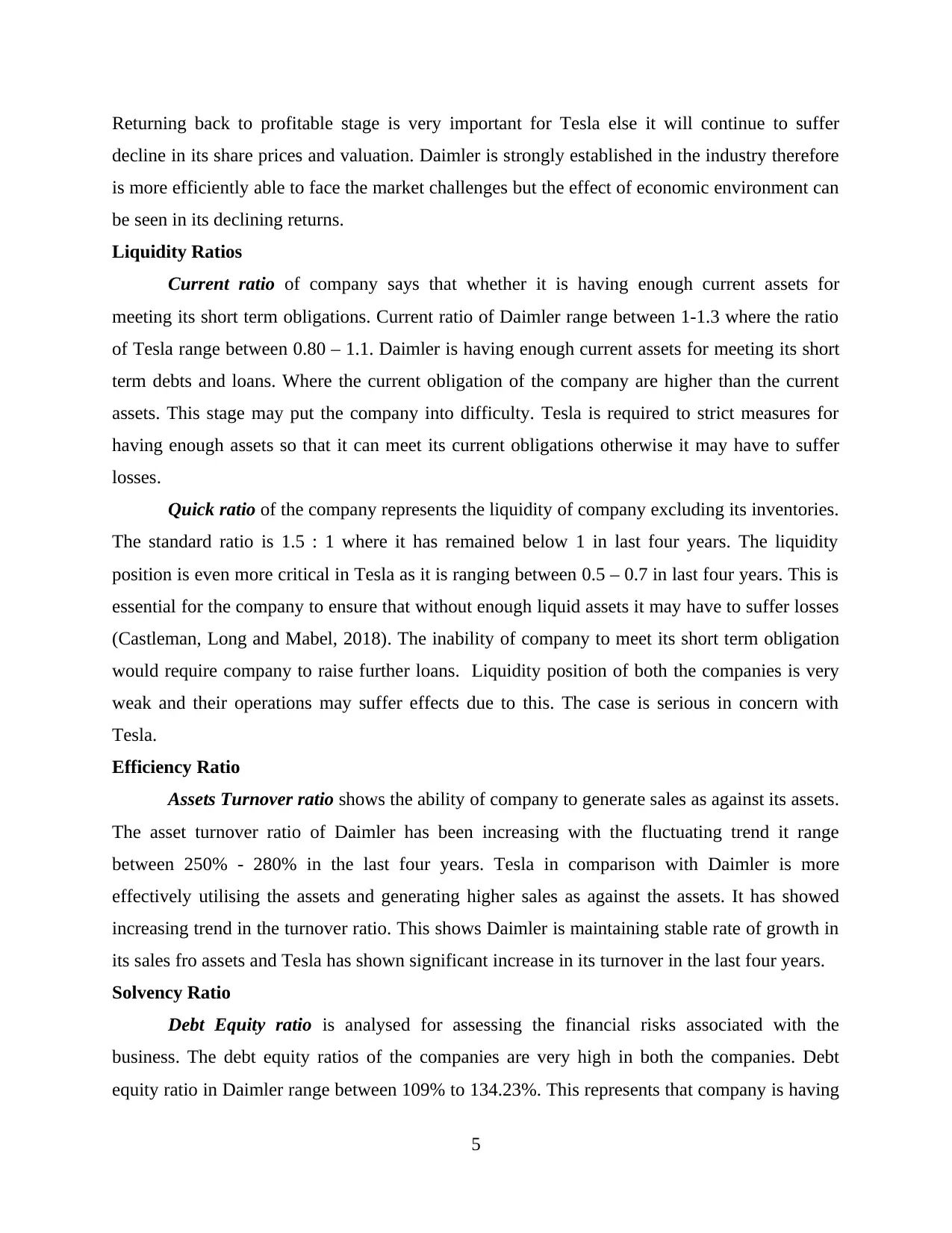
Returning back to profitable stage is very important for Tesla else it will continue to suffer
decline in its share prices and valuation. Daimler is strongly established in the industry therefore
is more efficiently able to face the market challenges but the effect of economic environment can
be seen in its declining returns.
Liquidity Ratios
Current ratio of company says that whether it is having enough current assets for
meeting its short term obligations. Current ratio of Daimler range between 1-1.3 where the ratio
of Tesla range between 0.80 – 1.1. Daimler is having enough current assets for meeting its short
term debts and loans. Where the current obligation of the company are higher than the current
assets. This stage may put the company into difficulty. Tesla is required to strict measures for
having enough assets so that it can meet its current obligations otherwise it may have to suffer
losses.
Quick ratio of the company represents the liquidity of company excluding its inventories.
The standard ratio is 1.5 : 1 where it has remained below 1 in last four years. The liquidity
position is even more critical in Tesla as it is ranging between 0.5 – 0.7 in last four years. This is
essential for the company to ensure that without enough liquid assets it may have to suffer losses
(Castleman, Long and Mabel, 2018). The inability of company to meet its short term obligation
would require company to raise further loans. Liquidity position of both the companies is very
weak and their operations may suffer effects due to this. The case is serious in concern with
Tesla.
Efficiency Ratio
Assets Turnover ratio shows the ability of company to generate sales as against its assets.
The asset turnover ratio of Daimler has been increasing with the fluctuating trend it range
between 250% - 280% in the last four years. Tesla in comparison with Daimler is more
effectively utilising the assets and generating higher sales as against the assets. It has showed
increasing trend in the turnover ratio. This shows Daimler is maintaining stable rate of growth in
its sales fro assets and Tesla has shown significant increase in its turnover in the last four years.
Solvency Ratio
Debt Equity ratio is analysed for assessing the financial risks associated with the
business. The debt equity ratios of the companies are very high in both the companies. Debt
equity ratio in Daimler range between 109% to 134.23%. This represents that company is having
5
decline in its share prices and valuation. Daimler is strongly established in the industry therefore
is more efficiently able to face the market challenges but the effect of economic environment can
be seen in its declining returns.
Liquidity Ratios
Current ratio of company says that whether it is having enough current assets for
meeting its short term obligations. Current ratio of Daimler range between 1-1.3 where the ratio
of Tesla range between 0.80 – 1.1. Daimler is having enough current assets for meeting its short
term debts and loans. Where the current obligation of the company are higher than the current
assets. This stage may put the company into difficulty. Tesla is required to strict measures for
having enough assets so that it can meet its current obligations otherwise it may have to suffer
losses.
Quick ratio of the company represents the liquidity of company excluding its inventories.
The standard ratio is 1.5 : 1 where it has remained below 1 in last four years. The liquidity
position is even more critical in Tesla as it is ranging between 0.5 – 0.7 in last four years. This is
essential for the company to ensure that without enough liquid assets it may have to suffer losses
(Castleman, Long and Mabel, 2018). The inability of company to meet its short term obligation
would require company to raise further loans. Liquidity position of both the companies is very
weak and their operations may suffer effects due to this. The case is serious in concern with
Tesla.
Efficiency Ratio
Assets Turnover ratio shows the ability of company to generate sales as against its assets.
The asset turnover ratio of Daimler has been increasing with the fluctuating trend it range
between 250% - 280% in the last four years. Tesla in comparison with Daimler is more
effectively utilising the assets and generating higher sales as against the assets. It has showed
increasing trend in the turnover ratio. This shows Daimler is maintaining stable rate of growth in
its sales fro assets and Tesla has shown significant increase in its turnover in the last four years.
Solvency Ratio
Debt Equity ratio is analysed for assessing the financial risks associated with the
business. The debt equity ratios of the companies are very high in both the companies. Debt
equity ratio in Daimler range between 109% to 134.23%. This represents that company is having
5
Paraphrase This Document
Need a fresh take? Get an instant paraphrase of this document with our AI Paraphraser
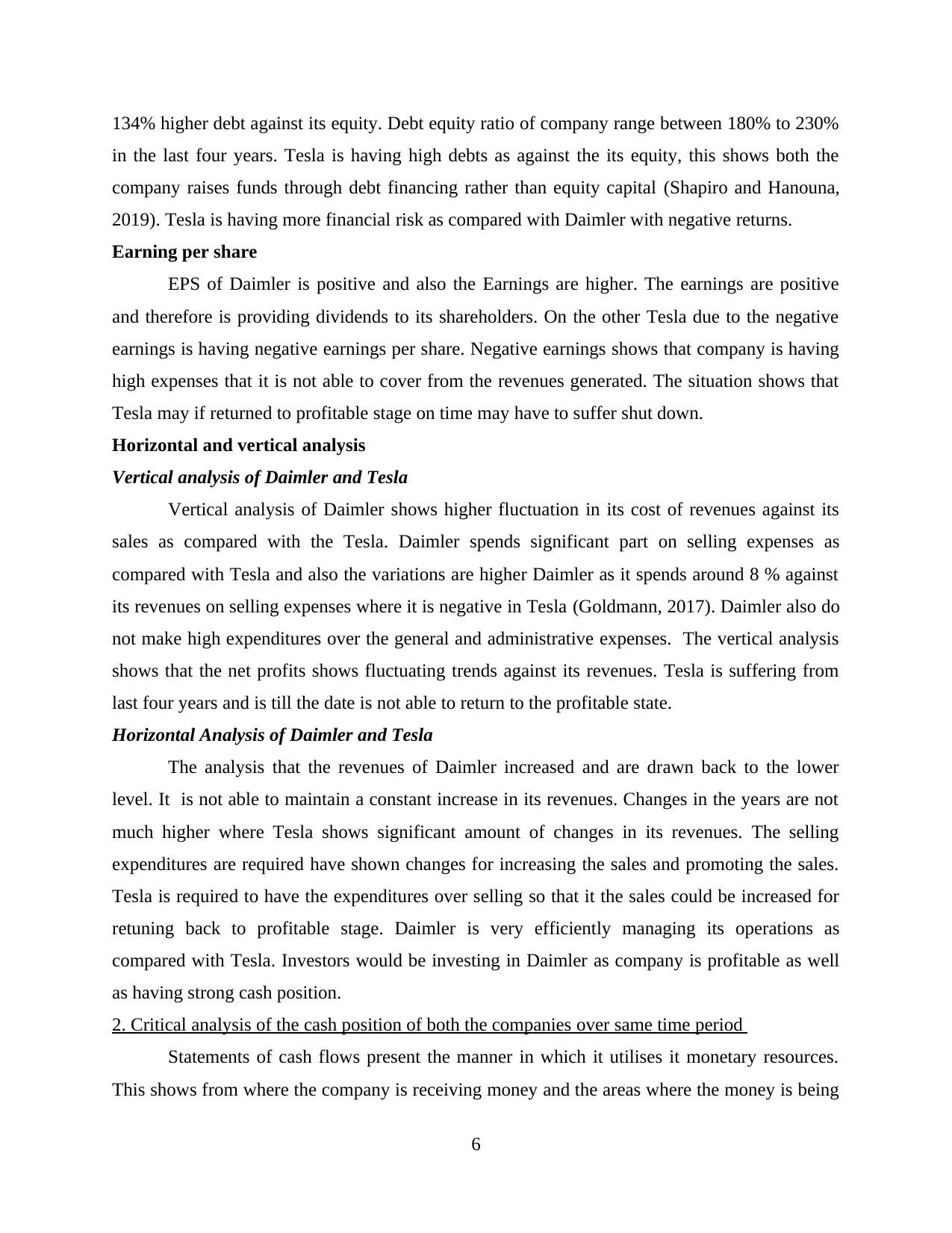
134% higher debt against its equity. Debt equity ratio of company range between 180% to 230%
in the last four years. Tesla is having high debts as against the its equity, this shows both the
company raises funds through debt financing rather than equity capital (Shapiro and Hanouna,
2019). Tesla is having more financial risk as compared with Daimler with negative returns.
Earning per share
EPS of Daimler is positive and also the Earnings are higher. The earnings are positive
and therefore is providing dividends to its shareholders. On the other Tesla due to the negative
earnings is having negative earnings per share. Negative earnings shows that company is having
high expenses that it is not able to cover from the revenues generated. The situation shows that
Tesla may if returned to profitable stage on time may have to suffer shut down.
Horizontal and vertical analysis
Vertical analysis of Daimler and Tesla
Vertical analysis of Daimler shows higher fluctuation in its cost of revenues against its
sales as compared with the Tesla. Daimler spends significant part on selling expenses as
compared with Tesla and also the variations are higher Daimler as it spends around 8 % against
its revenues on selling expenses where it is negative in Tesla (Goldmann, 2017). Daimler also do
not make high expenditures over the general and administrative expenses. The vertical analysis
shows that the net profits shows fluctuating trends against its revenues. Tesla is suffering from
last four years and is till the date is not able to return to the profitable state.
Horizontal Analysis of Daimler and Tesla
The analysis that the revenues of Daimler increased and are drawn back to the lower
level. It is not able to maintain a constant increase in its revenues. Changes in the years are not
much higher where Tesla shows significant amount of changes in its revenues. The selling
expenditures are required have shown changes for increasing the sales and promoting the sales.
Tesla is required to have the expenditures over selling so that it the sales could be increased for
retuning back to profitable stage. Daimler is very efficiently managing its operations as
compared with Tesla. Investors would be investing in Daimler as company is profitable as well
as having strong cash position.
2. Critical analysis of the cash position of both the companies over same time period
Statements of cash flows present the manner in which it utilises it monetary resources.
This shows from where the company is receiving money and the areas where the money is being
6
in the last four years. Tesla is having high debts as against the its equity, this shows both the
company raises funds through debt financing rather than equity capital (Shapiro and Hanouna,
2019). Tesla is having more financial risk as compared with Daimler with negative returns.
Earning per share
EPS of Daimler is positive and also the Earnings are higher. The earnings are positive
and therefore is providing dividends to its shareholders. On the other Tesla due to the negative
earnings is having negative earnings per share. Negative earnings shows that company is having
high expenses that it is not able to cover from the revenues generated. The situation shows that
Tesla may if returned to profitable stage on time may have to suffer shut down.
Horizontal and vertical analysis
Vertical analysis of Daimler and Tesla
Vertical analysis of Daimler shows higher fluctuation in its cost of revenues against its
sales as compared with the Tesla. Daimler spends significant part on selling expenses as
compared with Tesla and also the variations are higher Daimler as it spends around 8 % against
its revenues on selling expenses where it is negative in Tesla (Goldmann, 2017). Daimler also do
not make high expenditures over the general and administrative expenses. The vertical analysis
shows that the net profits shows fluctuating trends against its revenues. Tesla is suffering from
last four years and is till the date is not able to return to the profitable state.
Horizontal Analysis of Daimler and Tesla
The analysis that the revenues of Daimler increased and are drawn back to the lower
level. It is not able to maintain a constant increase in its revenues. Changes in the years are not
much higher where Tesla shows significant amount of changes in its revenues. The selling
expenditures are required have shown changes for increasing the sales and promoting the sales.
Tesla is required to have the expenditures over selling so that it the sales could be increased for
retuning back to profitable stage. Daimler is very efficiently managing its operations as
compared with Tesla. Investors would be investing in Daimler as company is profitable as well
as having strong cash position.
2. Critical analysis of the cash position of both the companies over same time period
Statements of cash flows present the manner in which it utilises it monetary resources.
This shows from where the company is receiving money and the areas where the money is being
6
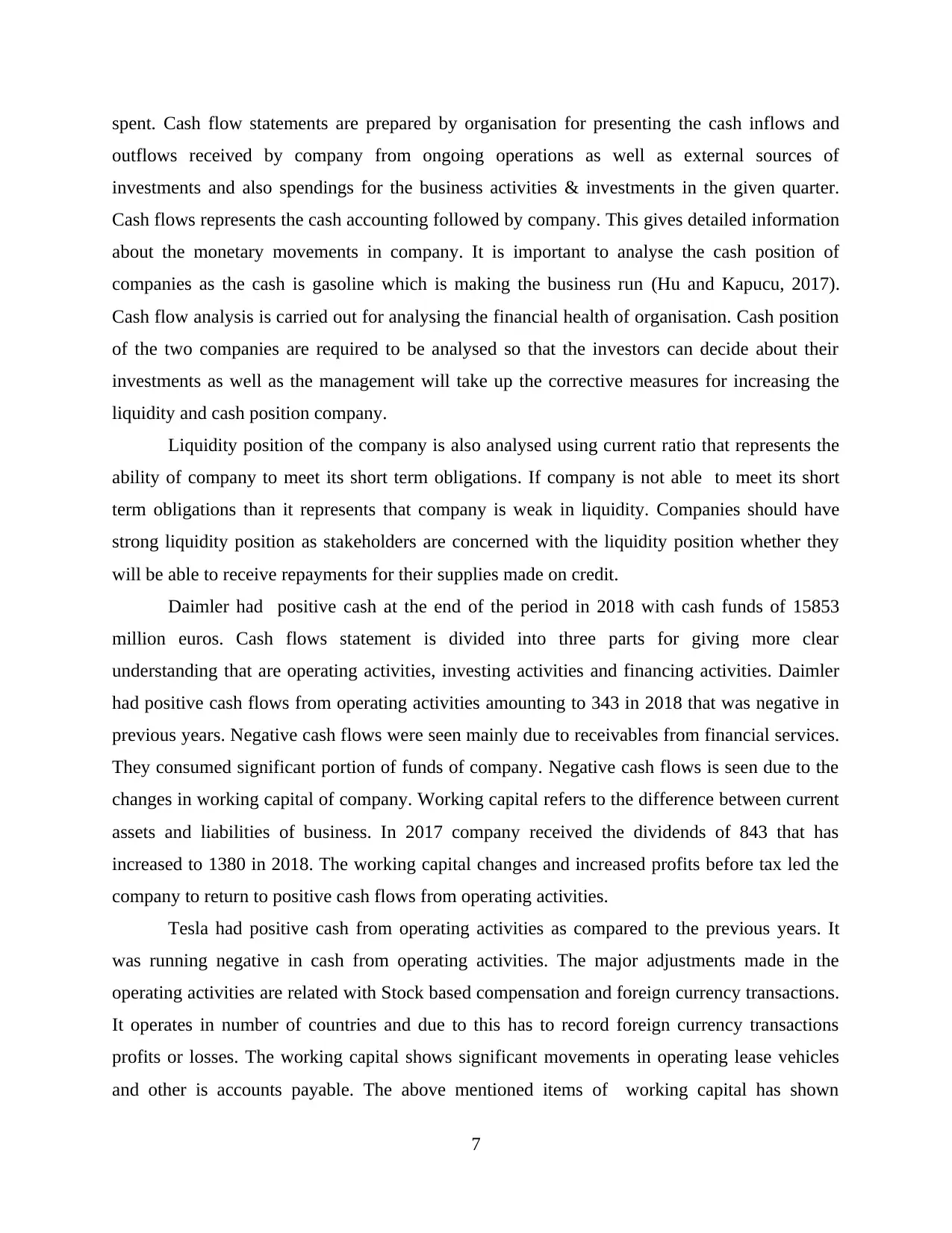
spent. Cash flow statements are prepared by organisation for presenting the cash inflows and
outflows received by company from ongoing operations as well as external sources of
investments and also spendings for the business activities & investments in the given quarter.
Cash flows represents the cash accounting followed by company. This gives detailed information
about the monetary movements in company. It is important to analyse the cash position of
companies as the cash is gasoline which is making the business run (Hu and Kapucu, 2017).
Cash flow analysis is carried out for analysing the financial health of organisation. Cash position
of the two companies are required to be analysed so that the investors can decide about their
investments as well as the management will take up the corrective measures for increasing the
liquidity and cash position company.
Liquidity position of the company is also analysed using current ratio that represents the
ability of company to meet its short term obligations. If company is not able to meet its short
term obligations than it represents that company is weak in liquidity. Companies should have
strong liquidity position as stakeholders are concerned with the liquidity position whether they
will be able to receive repayments for their supplies made on credit.
Daimler had positive cash at the end of the period in 2018 with cash funds of 15853
million euros. Cash flows statement is divided into three parts for giving more clear
understanding that are operating activities, investing activities and financing activities. Daimler
had positive cash flows from operating activities amounting to 343 in 2018 that was negative in
previous years. Negative cash flows were seen mainly due to receivables from financial services.
They consumed significant portion of funds of company. Negative cash flows is seen due to the
changes in working capital of company. Working capital refers to the difference between current
assets and liabilities of business. In 2017 company received the dividends of 843 that has
increased to 1380 in 2018. The working capital changes and increased profits before tax led the
company to return to positive cash flows from operating activities.
Tesla had positive cash from operating activities as compared to the previous years. It
was running negative in cash from operating activities. The major adjustments made in the
operating activities are related with Stock based compensation and foreign currency transactions.
It operates in number of countries and due to this has to record foreign currency transactions
profits or losses. The working capital shows significant movements in operating lease vehicles
and other is accounts payable. The above mentioned items of working capital has shown
7
outflows received by company from ongoing operations as well as external sources of
investments and also spendings for the business activities & investments in the given quarter.
Cash flows represents the cash accounting followed by company. This gives detailed information
about the monetary movements in company. It is important to analyse the cash position of
companies as the cash is gasoline which is making the business run (Hu and Kapucu, 2017).
Cash flow analysis is carried out for analysing the financial health of organisation. Cash position
of the two companies are required to be analysed so that the investors can decide about their
investments as well as the management will take up the corrective measures for increasing the
liquidity and cash position company.
Liquidity position of the company is also analysed using current ratio that represents the
ability of company to meet its short term obligations. If company is not able to meet its short
term obligations than it represents that company is weak in liquidity. Companies should have
strong liquidity position as stakeholders are concerned with the liquidity position whether they
will be able to receive repayments for their supplies made on credit.
Daimler had positive cash at the end of the period in 2018 with cash funds of 15853
million euros. Cash flows statement is divided into three parts for giving more clear
understanding that are operating activities, investing activities and financing activities. Daimler
had positive cash flows from operating activities amounting to 343 in 2018 that was negative in
previous years. Negative cash flows were seen mainly due to receivables from financial services.
They consumed significant portion of funds of company. Negative cash flows is seen due to the
changes in working capital of company. Working capital refers to the difference between current
assets and liabilities of business. In 2017 company received the dividends of 843 that has
increased to 1380 in 2018. The working capital changes and increased profits before tax led the
company to return to positive cash flows from operating activities.
Tesla had positive cash from operating activities as compared to the previous years. It
was running negative in cash from operating activities. The major adjustments made in the
operating activities are related with Stock based compensation and foreign currency transactions.
It operates in number of countries and due to this has to record foreign currency transactions
profits or losses. The working capital shows significant movements in operating lease vehicles
and other is accounts payable. The above mentioned items of working capital has shown
7
⊘ This is a preview!⊘
Do you want full access?
Subscribe today to unlock all pages.

Trusted by 1+ million students worldwide
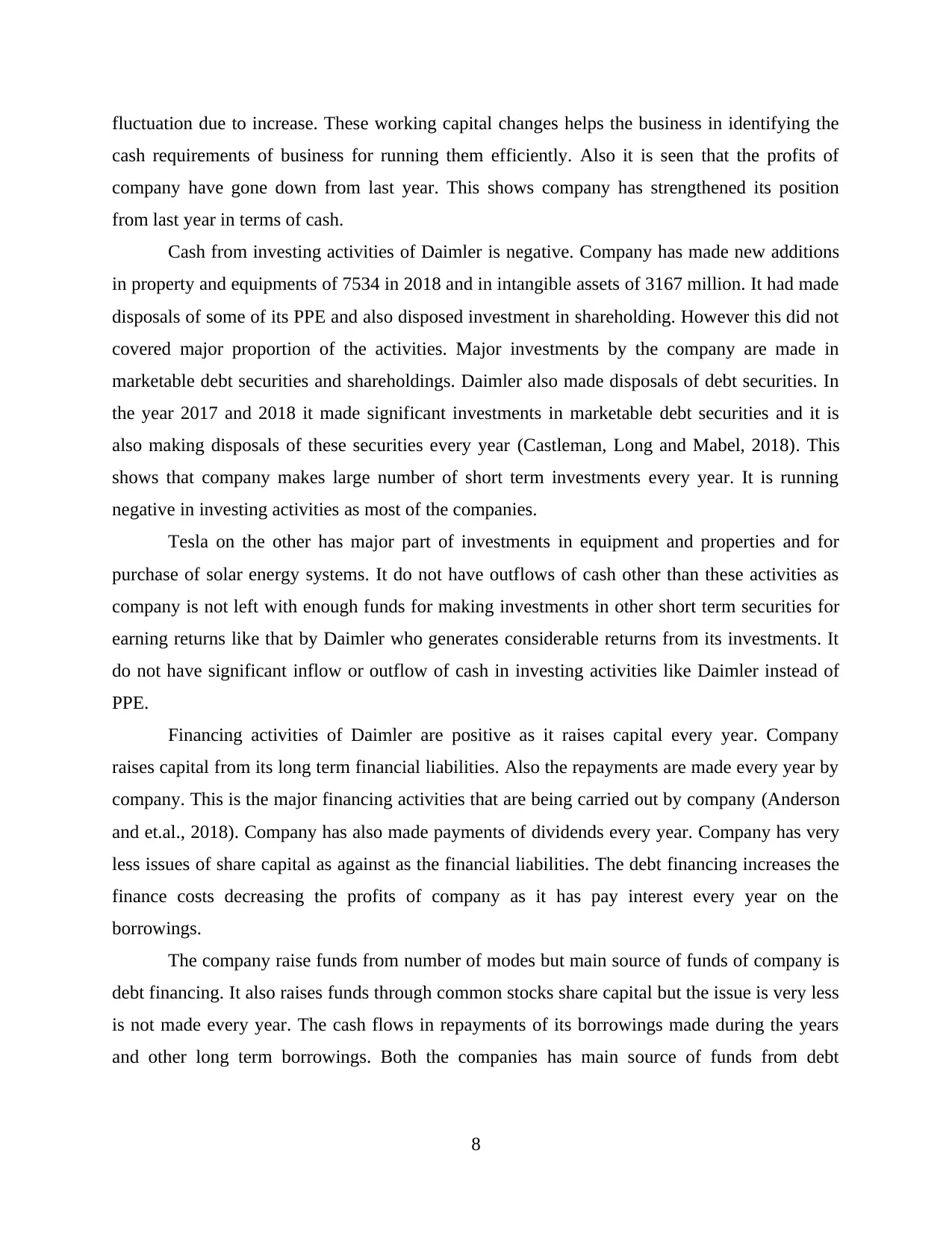
fluctuation due to increase. These working capital changes helps the business in identifying the
cash requirements of business for running them efficiently. Also it is seen that the profits of
company have gone down from last year. This shows company has strengthened its position
from last year in terms of cash.
Cash from investing activities of Daimler is negative. Company has made new additions
in property and equipments of 7534 in 2018 and in intangible assets of 3167 million. It had made
disposals of some of its PPE and also disposed investment in shareholding. However this did not
covered major proportion of the activities. Major investments by the company are made in
marketable debt securities and shareholdings. Daimler also made disposals of debt securities. In
the year 2017 and 2018 it made significant investments in marketable debt securities and it is
also making disposals of these securities every year (Castleman, Long and Mabel, 2018). This
shows that company makes large number of short term investments every year. It is running
negative in investing activities as most of the companies.
Tesla on the other has major part of investments in equipment and properties and for
purchase of solar energy systems. It do not have outflows of cash other than these activities as
company is not left with enough funds for making investments in other short term securities for
earning returns like that by Daimler who generates considerable returns from its investments. It
do not have significant inflow or outflow of cash in investing activities like Daimler instead of
PPE.
Financing activities of Daimler are positive as it raises capital every year. Company
raises capital from its long term financial liabilities. Also the repayments are made every year by
company. This is the major financing activities that are being carried out by company (Anderson
and et.al., 2018). Company has also made payments of dividends every year. Company has very
less issues of share capital as against as the financial liabilities. The debt financing increases the
finance costs decreasing the profits of company as it has pay interest every year on the
borrowings.
The company raise funds from number of modes but main source of funds of company is
debt financing. It also raises funds through common stocks share capital but the issue is very less
is not made every year. The cash flows in repayments of its borrowings made during the years
and other long term borrowings. Both the companies has main source of funds from debt
8
cash requirements of business for running them efficiently. Also it is seen that the profits of
company have gone down from last year. This shows company has strengthened its position
from last year in terms of cash.
Cash from investing activities of Daimler is negative. Company has made new additions
in property and equipments of 7534 in 2018 and in intangible assets of 3167 million. It had made
disposals of some of its PPE and also disposed investment in shareholding. However this did not
covered major proportion of the activities. Major investments by the company are made in
marketable debt securities and shareholdings. Daimler also made disposals of debt securities. In
the year 2017 and 2018 it made significant investments in marketable debt securities and it is
also making disposals of these securities every year (Castleman, Long and Mabel, 2018). This
shows that company makes large number of short term investments every year. It is running
negative in investing activities as most of the companies.
Tesla on the other has major part of investments in equipment and properties and for
purchase of solar energy systems. It do not have outflows of cash other than these activities as
company is not left with enough funds for making investments in other short term securities for
earning returns like that by Daimler who generates considerable returns from its investments. It
do not have significant inflow or outflow of cash in investing activities like Daimler instead of
PPE.
Financing activities of Daimler are positive as it raises capital every year. Company
raises capital from its long term financial liabilities. Also the repayments are made every year by
company. This is the major financing activities that are being carried out by company (Anderson
and et.al., 2018). Company has also made payments of dividends every year. Company has very
less issues of share capital as against as the financial liabilities. The debt financing increases the
finance costs decreasing the profits of company as it has pay interest every year on the
borrowings.
The company raise funds from number of modes but main source of funds of company is
debt financing. It also raises funds through common stocks share capital but the issue is very less
is not made every year. The cash flows in repayments of its borrowings made during the years
and other long term borrowings. Both the companies has main source of funds from debt
8
Paraphrase This Document
Need a fresh take? Get an instant paraphrase of this document with our AI Paraphraser
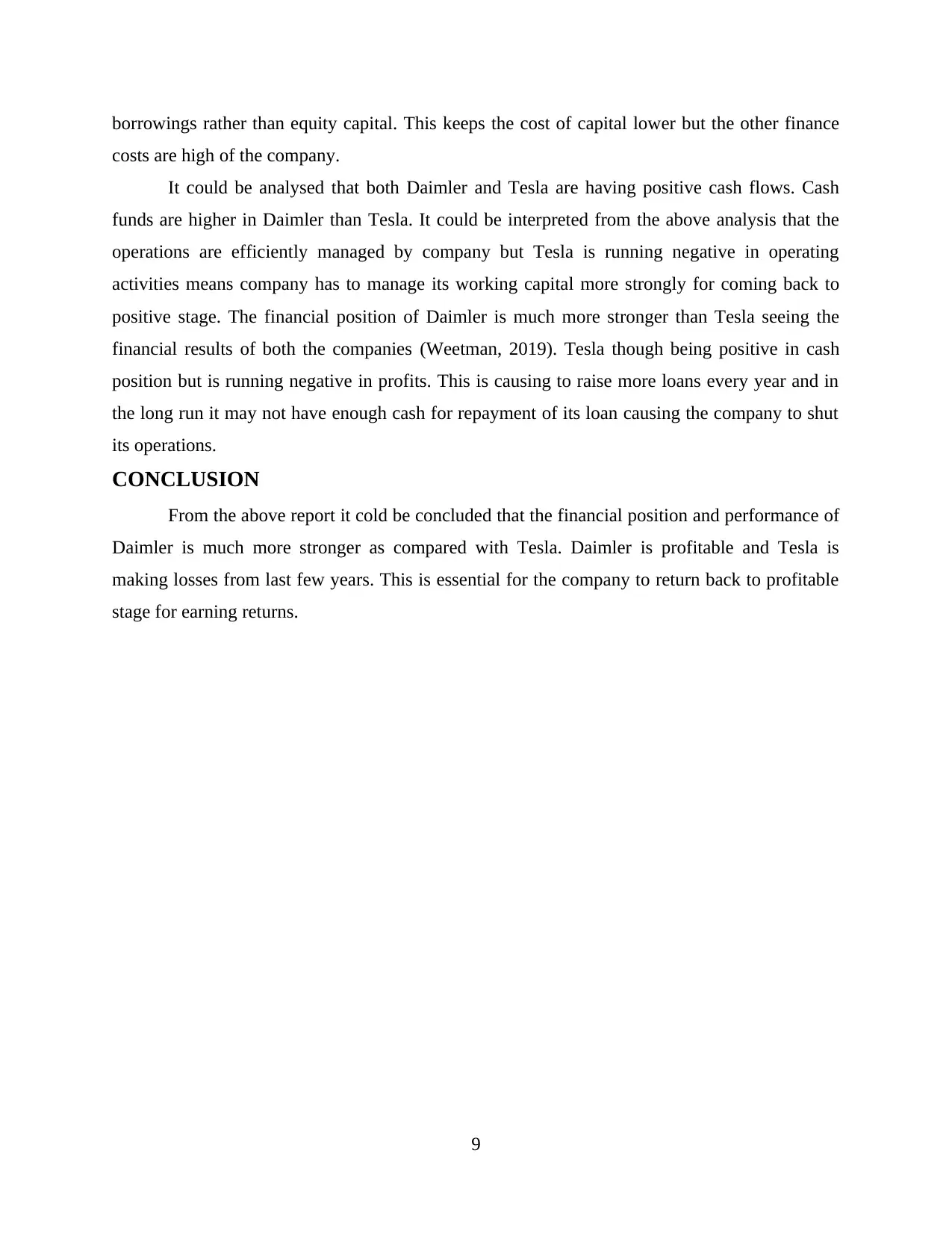
borrowings rather than equity capital. This keeps the cost of capital lower but the other finance
costs are high of the company.
It could be analysed that both Daimler and Tesla are having positive cash flows. Cash
funds are higher in Daimler than Tesla. It could be interpreted from the above analysis that the
operations are efficiently managed by company but Tesla is running negative in operating
activities means company has to manage its working capital more strongly for coming back to
positive stage. The financial position of Daimler is much more stronger than Tesla seeing the
financial results of both the companies (Weetman, 2019). Tesla though being positive in cash
position but is running negative in profits. This is causing to raise more loans every year and in
the long run it may not have enough cash for repayment of its loan causing the company to shut
its operations.
CONCLUSION
From the above report it cold be concluded that the financial position and performance of
Daimler is much more stronger as compared with Tesla. Daimler is profitable and Tesla is
making losses from last few years. This is essential for the company to return back to profitable
stage for earning returns.
9
costs are high of the company.
It could be analysed that both Daimler and Tesla are having positive cash flows. Cash
funds are higher in Daimler than Tesla. It could be interpreted from the above analysis that the
operations are efficiently managed by company but Tesla is running negative in operating
activities means company has to manage its working capital more strongly for coming back to
positive stage. The financial position of Daimler is much more stronger than Tesla seeing the
financial results of both the companies (Weetman, 2019). Tesla though being positive in cash
position but is running negative in profits. This is causing to raise more loans every year and in
the long run it may not have enough cash for repayment of its loan causing the company to shut
its operations.
CONCLUSION
From the above report it cold be concluded that the financial position and performance of
Daimler is much more stronger as compared with Tesla. Daimler is profitable and Tesla is
making losses from last few years. This is essential for the company to return back to profitable
stage for earning returns.
9
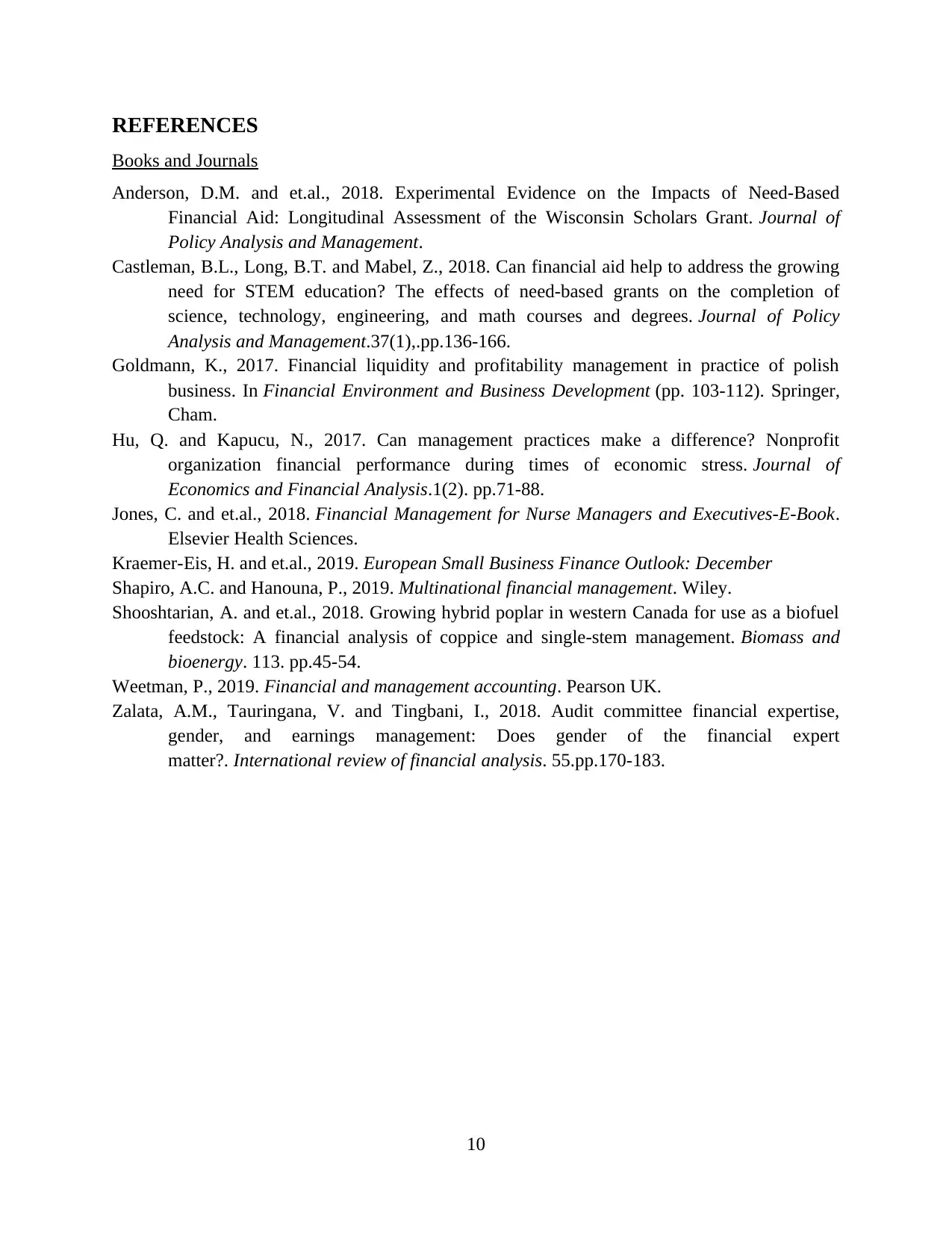
REFERENCES
Books and Journals
Anderson, D.M. and et.al., 2018. Experimental Evidence on the Impacts of Need‐Based
Financial Aid: Longitudinal Assessment of the Wisconsin Scholars Grant. Journal of
Policy Analysis and Management.
Castleman, B.L., Long, B.T. and Mabel, Z., 2018. Can financial aid help to address the growing
need for STEM education? The effects of need‐based grants on the completion of
science, technology, engineering, and math courses and degrees. Journal of Policy
Analysis and Management.37(1),.pp.136-166.
Goldmann, K., 2017. Financial liquidity and profitability management in practice of polish
business. In Financial Environment and Business Development (pp. 103-112). Springer,
Cham.
Hu, Q. and Kapucu, N., 2017. Can management practices make a difference? Nonprofit
organization financial performance during times of economic stress. Journal of
Economics and Financial Analysis.1(2). pp.71-88.
Jones, C. and et.al., 2018. Financial Management for Nurse Managers and Executives-E-Book.
Elsevier Health Sciences.
Kraemer-Eis, H. and et.al., 2019. European Small Business Finance Outlook: December
Shapiro, A.C. and Hanouna, P., 2019. Multinational financial management. Wiley.
Shooshtarian, A. and et.al., 2018. Growing hybrid poplar in western Canada for use as a biofuel
feedstock: A financial analysis of coppice and single-stem management. Biomass and
bioenergy. 113. pp.45-54.
Weetman, P., 2019. Financial and management accounting. Pearson UK.
Zalata, A.M., Tauringana, V. and Tingbani, I., 2018. Audit committee financial expertise,
gender, and earnings management: Does gender of the financial expert
matter?. International review of financial analysis. 55.pp.170-183.
10
Books and Journals
Anderson, D.M. and et.al., 2018. Experimental Evidence on the Impacts of Need‐Based
Financial Aid: Longitudinal Assessment of the Wisconsin Scholars Grant. Journal of
Policy Analysis and Management.
Castleman, B.L., Long, B.T. and Mabel, Z., 2018. Can financial aid help to address the growing
need for STEM education? The effects of need‐based grants on the completion of
science, technology, engineering, and math courses and degrees. Journal of Policy
Analysis and Management.37(1),.pp.136-166.
Goldmann, K., 2017. Financial liquidity and profitability management in practice of polish
business. In Financial Environment and Business Development (pp. 103-112). Springer,
Cham.
Hu, Q. and Kapucu, N., 2017. Can management practices make a difference? Nonprofit
organization financial performance during times of economic stress. Journal of
Economics and Financial Analysis.1(2). pp.71-88.
Jones, C. and et.al., 2018. Financial Management for Nurse Managers and Executives-E-Book.
Elsevier Health Sciences.
Kraemer-Eis, H. and et.al., 2019. European Small Business Finance Outlook: December
Shapiro, A.C. and Hanouna, P., 2019. Multinational financial management. Wiley.
Shooshtarian, A. and et.al., 2018. Growing hybrid poplar in western Canada for use as a biofuel
feedstock: A financial analysis of coppice and single-stem management. Biomass and
bioenergy. 113. pp.45-54.
Weetman, P., 2019. Financial and management accounting. Pearson UK.
Zalata, A.M., Tauringana, V. and Tingbani, I., 2018. Audit committee financial expertise,
gender, and earnings management: Does gender of the financial expert
matter?. International review of financial analysis. 55.pp.170-183.
10
⊘ This is a preview!⊘
Do you want full access?
Subscribe today to unlock all pages.

Trusted by 1+ million students worldwide
1 out of 17
Related Documents
Your All-in-One AI-Powered Toolkit for Academic Success.
+13062052269
info@desklib.com
Available 24*7 on WhatsApp / Email
![[object Object]](/_next/static/media/star-bottom.7253800d.svg)
Unlock your academic potential
Copyright © 2020–2025 A2Z Services. All Rights Reserved. Developed and managed by ZUCOL.





